Related Research Articles
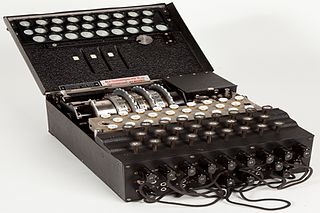
The Enigma machine is a cipher device developed and used in the early- to mid-20th century to protect commercial, diplomatic, and military communication. It was employed extensively by Nazi Germany during World War II, in all branches of the German military. The Enigma machine was considered so secure that it was used to encipher the most top-secret messages.

Government Communications Headquarters (GCHQ), is an intelligence and security organisation responsible for providing signals intelligence (SIGINT) and information assurance (IA) to the government and armed forces of the United Kingdom. Primarily based at "The Doughnut" in the suburbs of Cheltenham, GCHQ is the responsibility of the country's Secretary of State for Foreign and Commonwealth Affairs, but it is not a part of the Foreign Office and its Director ranks as a Permanent Secretary.

In the history of cryptography, Typex machines were British cipher machines used from 1937. It was an adaptation of the commercial German Enigma with a number of enhancements that greatly increased its security. The cipher machine was used until the mid-1950s when other more modern military encryption systems came into use.

The Security Service, also known as MI5, is the United Kingdom's domestic counter-intelligence and security agency and is part of its intelligence machinery alongside the Secret Intelligence Service (MI6), Government Communications Headquarters (GCHQ), and Defence Intelligence (DI). MI5 is directed by the Joint Intelligence Committee (JIC), and the service is bound by the Security Service Act 1989. The service is directed to protect British parliamentary democracy and economic interests and to counter terrorism and espionage within the United Kingdom (UK).

David Kahn is an American historian, journalist, and writer. He has written extensively on the history of cryptography and military intelligence.
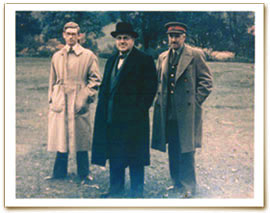
Brigadier John Hessell Tiltman, was a British Army officer who worked in intelligence, often at or with the Government Code and Cypher School (GC&CS) starting in the 1920s. His intelligence work was largely connected with cryptography, and he showed exceptional skill at cryptanalysis. His work in association with Bill Tutte on the cryptanalysis of the Lorenz cipher, the German teleprinter cipher, called "Tunny" at Bletchley Park, led to breakthroughs in attack methods on the code, without a computer. It was to exploit those methods, at extremely high speed with great reliability, that Colossus, the first digital programmable electronic computer, was designed and built.

The United Kingdom – United States of America Agreement is a multilateral agreement for cooperation in signals intelligence between Australia, Canada, New Zealand, the United Kingdom, and the United States. The alliance of intelligence operations is also known as the Five Eyes. In classification markings this is abbreviated as FVEY, with the individual countries being abbreviated as AUS, CAN, NZL, GBR, and USA, respectively.
Commander Alexander "Alastair" Guthrie Denniston was a Scottish codebreaker in Room 40, deputy head of the Government Code and Cypher School (GC&CS) and hockey player. Denniston was appointed operational head of GC&CS in 1919 and remained so until February 1942.

The Intelligence Services Act 1994 is an Act of the Parliament of the United Kingdom.

Sir David Bruce Omand is a British former senior civil servant who served as the Director of the Government Communications Headquarters (GCHQ) from 1996 to 1997.
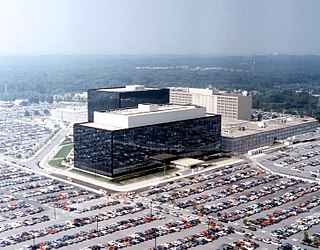
The Five Eyes (FVEY) is an intelligence alliance comprising Australia, Canada, New Zealand, the United Kingdom, and the United States. These countries are parties to the multilateral UKUSA Agreement, a treaty for joint cooperation in signals intelligence. Informally, Five Eyes can also refer to the group of intelligence agencies of these countries.
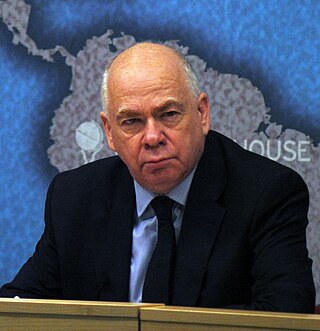
Sir Lawrence David Freedman, is a British academic, historian and author with specialising in foreign policy, international relations and strategy. He has been described as the "dean of British strategic studies" and was a member of the Iraq Inquiry. He is an Emeritus Professor of War Studies at King's College London.
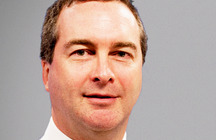
Robert Peter Hannigan CMG is a cybersecurity specialist who has been Warden of Wadham College, Oxford, since 2021. He was a senior British civil servant who previously served as the director of the signals intelligence and cryptography agency the Government Communications Headquarters (GCHQ) and established the UK's National Cyber Security Centre. His sudden resignation as director was announced on 23 January 2017, and he stepped down at the end of April 2017 to pursue a career in private sector cyber security, academia and as a security commentator. In 2021 he became Warden of Wadham College, Oxford.

The Secret Intelligence Service (SIS), commonly known as MI6, is the foreign intelligence service of the United Kingdom, tasked mainly with the covert overseas collection and analysis of human intelligence in support of the UK's national security. SIS is one of the British intelligence agencies and the Chief of the Secret Intelligence Service ("C") is directly accountable to the Foreign Secretary.

The use of electronic surveillance by the United Kingdom grew from the development of signal intelligence and pioneering code breaking during World War II. In the post-war period, the Government Communications Headquarters (GCHQ) was formed and participated in programmes such as the Five Eyes collaboration of English-speaking nations. This focused on intercepting electronic communications, with substantial increases in surveillance capabilities over time. A series of media reports in 2013 revealed bulk collection and surveillance capabilities, including collection and sharing collaborations between GCHQ and the United States' National Security Agency. These were commonly described by the media and civil liberties groups as mass surveillance. Similar capabilities exist in other countries, including western European countries.

Ongoing news reports in the international media have revealed operational details about the Anglophone cryptographic agencies' global surveillance of both foreign and domestic nationals. The reports mostly emanate from a cache of top secret documents leaked by ex-NSA contractor Edward Snowden, which he obtained whilst working for Booz Allen Hamilton, one of the largest contractors for defense and intelligence in the United States. In addition to a trove of U.S. federal documents, Snowden's cache reportedly contains thousands of Australian, British, Canadian and New Zealand intelligence files that he had accessed via the exclusive "Five Eyes" network. In June 2013, the first of Snowden's documents were published simultaneously by The Washington Post and The Guardian, attracting considerable public attention. The disclosure continued throughout 2013, and a small portion of the estimated full cache of documents was later published by other media outlets worldwide, most notably The New York Times, the Canadian Broadcasting Corporation, the Australian Broadcasting Corporation, Der Spiegel (Germany), O Globo (Brazil), Le Monde (France), L'espresso (Italy), NRC Handelsblad, Dagbladet (Norway), El País (Spain), and Sveriges Television (Sweden).
The Government of the United Kingdom maintains several intelligence agencies that deal with secret intelligence. These agencies are responsible for collecting, analysing and exploiting foreign and domestic intelligence, providing military intelligence, and performing espionage and counter-espionage. Their intelligence assessments contribute to the conduct of the foreign relations of the United Kingdom, maintaining the national security of the United Kingdom, military planning, public safety, and law enforcement in the United Kingdom. The four main agencies are the Secret Intelligence Service, the Security Service (MI5), the Government Communications Headquarters (GCHQ) and Defence Intelligence (DI). The agencies are organised under three government departments, the Foreign Office, the Home Office and the Ministry of Defence.
Sir Jeremy Ian Fleming is the Director of the Government Communications Headquarters, the UK's intelligence, cyber and security agency. He was appointed in 2017 and is the 16th person to hold the role. He will leave the post in May 2023.

Prof: Alan Turing Decoded is a 2015 biography of Alan Turing, a 20th-century mathematician and computer scientist, authored by his nephew Dermot Turing. Written in a non-academic style, it begins with Turing's family history and early childhood, continuing with his contributions to Britain's cryptanalysis and encryption efforts in World War II and culminating in Turing's conviction for homosexuality and his later suicide.
Patricia Marjorie Bartley, Mrs Brown was a British codebreaker at Bletchley Park, and a member of British intelligence's diplomatic office in Mayfair, London. Among her contributions to the war effort was the breaking of the German diplomatic Floradora code, a task accomplished by a team she led.
References
- 1 2 "GCHQ's history told for the first time in Behind the Enigma". gchq.gov.uk. 20 October 2020. Retrieved 5 April 2021.
- 1 2 Harding, Luke (21 October 2020). "Behind the Enigma by John Ferris review – inside Britain's most secret intelligence agency". The Guardian. Retrieved 5 April 2021.
- ↑ FreedmanMarch/April 2021, Lawrence D. (2021-04-15). "A Review of "Behind the Enigma" by John Ferris". Foreign Affairs . ISSN 0015-7120 . Retrieved 2023-01-25.
- ↑ Urban, Mark. "Behind the Enigma by John Ferris, review — the not-so-super spies of GCHQ". The Times . ISSN 0140-0460 . Retrieved 2023-01-25.
- ↑ Marks, Philip (2023-01-16). "Review of Behind the Enigma by John Ferris". Cryptologia: 1–30. doi:10.1080/01611194.2022.2156311. ISSN 0161-1194. S2CID 256126968.